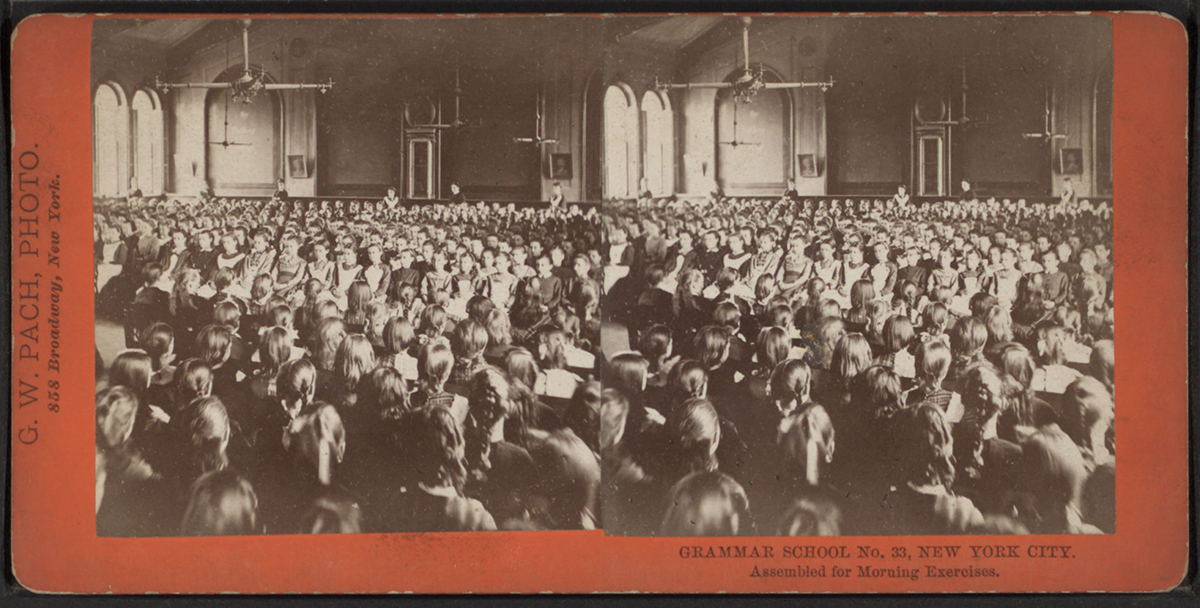You are here:
Grammar School No. 33, New York City, Assembled for Morning Exercises

Date: c. 1880-1890
Caption: A school auditorium full of elementary- or middle-school-aged students.

New York City’s rapid growth in the 1880s and 1890s meant a dramatically increasing number of children in the city, and in schools. Not every child in New York attended school. Starting in 1874 New York State had laws that required students of some ages to attend school, but there was little enforcement and there were loopholes that allowed families to keep children out of school if the family said they needed the child to work. Continued racial segregation by law in some parts of the city limited Black students’ access to some schools. Meanwhile some Disabled children were not considered eligible for schooling, so these young people were excluded from school.1
Despite these limitations on who attended, New York City’s schools and classrooms were bursting at the seams in the late 1800s and early 1900s. Many classrooms had more than fifty students, all seated close together on shared benches rather than individual desks. Having so many students and little space to move limited what kinds of work could happen in classrooms. Lectures, repetition, and memorization were common. Many teachers felt pressured to keep order and follow rules that were designed to move a huge number of students through the schools efficiently, rather than to support students as individuals.2
Many New York City schools still separated boys and girls in separate classes or entrances, but students were mixed together across many home languages. Although immigrant students often arrived in New York City with little familiarity in English, classes were taught only in English. Older students who had just arrived but spoke little English might be placed, awkwardly, in classrooms with very young students, in hopes that this would give them a chance to learn the language.3
-
Moses Stambler, “The Effect of Compulsory Education and Child Labor Laws on High School Attendance in New York City, 1898-1917, History of Education Quarterly, 8, no. 2 (Summer, 1968):189-214, https://www.jstor.org/stable/367352. On racial segregation in New York City schools, see the Elizabeth Cisco materials (on Jamaica, Queens); Judith Kafka, “The Colored People Have Dispersed,” GothamBlog, September 29, 2020, https://www.gothamcenter.org/blog/the-colored-people-have-dispersed-race-space-and-schooling-in-late-19th-century-brooklyn; and Advocates for Children, “Still Waiting, After all These Years: The Inclusion of Children with Special Needs in New York City Public Schools,” November 1, 2001, https://advocatesforchildren.org/policy-resource/lre-coalition-still-waiting. ↩︎
-
David B. Tyack, The One Best System: A History of American Urban Education (Cambridge: Harvard University Press, 1974) and Diane Ravitch, The Great School Wars: A History of the New York Public Schools (Baltimore: Basic Books, 1974). ↩︎
-
Larry Cuban, How Teachers Taught: Constancy and Change in American Classrooms, 1890-1980 (New York: Longman, 1984); Tyack, *The One Best System,” and Ravitch, The Great School Wars. ↩︎
Categories: Manhattan, K-12 organizing
Tags: immigrants and migrants, school facilities, photography, imagery, and visual representation, childhood
This item is part of "From the “Masses” to “Experts”" in "Who Governs Schools?"
Item Details
Date: c. 1880-1890
Creator: Gustavus W. Pach
Source: New York Public Library Digital Collections
Copyright: Public domain
How to cite: “Grammar School No. 33, New York City, Assembled for Morning Exercises,” Gustavus W. Pach, in New York City Civil Rights History Project, Accessed: [Month Day, Year], https://nyccivilrightshistory.org/gallery/grammar-school-33.
Questions to Consider
- Look at the young people in the room in the photograph. What do you notice about them? What do you think it felt like to be a student in this space? Do you think this would have been a supportive environment for the students? Why or why not?
- Look for the adults in the room. What do you notice about them? What do their positions in the room and body postures communicate?
- How do the students in the room appear to be similar to one another? Given what you know about who was attending school in New York City at the time, how might they have been different from one another?
References
How to Print this Page
- Press Ctrl + P or Cmd + P to open the print dialogue window.
- Under settings, choose "display headers and footers" if you want to print page numbers and the web address.
- Embedded PDF files will not print as part of the page. For best printing results, download the PDF and print from Adobe Reader or Preview.
